Polyosma hirsuta
Polyosma hirsuta, commonly known as hairy polyosma, is a plant in the family Escalloniaceae which is endemic to northeastern Queensland, Australia.[4][5] It is an evergreen small tree growing up to 10 m (33 ft) high. The leaves may be 6 to 14 cm (2.4 to 5.5 in) long and 2 to 5 cm (0.79 to 1.97 in) wide, often with toothed margins and each tooth exhibiting a short stiff spine.[4][5] Most parts of the plant, including the twigs, leaves and fruit, are clothed in fine pale brown hairs.[4][5]
| Hairy Polyosma | |
|---|---|
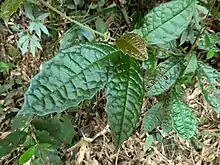 | |
| Growing on the Lamb Range near Cairns, October 2022 | |
| Scientific classification | |
| Kingdom: | Plantae |
| Clade: | Tracheophytes |
| Clade: | Angiosperms |
| Clade: | Eudicots |
| Clade: | Asterids |
| Order: | Escalloniales |
| Family: | Escalloniaceae |
| Genus: | Polyosma |
| Species: | P. hirsuta |
| Binomial name | |
| Polyosma hirsuta | |
The inflorescence is a raceme (an unbranched spike) produced in the leaf axils or at the ends of branches.[4][5] The cream-coloured flowers are tubular, about 12 mm (0.47 in) long by 3 mm (0.12 in) wide.[4][5] The fruit is a rounded or ovoid, dark purple or black berry containing a single seed. The fruit measures about 20 mm × 14 mm (0.79 in × 0.55 in) and the seed about 10 mm × 7 mm (0.39 in × 0.28 in).[4][5]
Taxonomy
The hairy polyosma was first described in 1918 by the Australian botanist Cyril Tenison White, based on material collected by the Reverend Norman Michael, an enthusiastic collector of botanic specimens in Queensland.[4][6] Michael found the plant in the vicintiy of the Johnstone River.[2][4] White's description was published in Botany Bulletin, a publication of the then Queensland Department of Agriculture.[2][4]
Distribution and habitat
Polyosma hirsuta is restricted to a small part of northeastern Queensland, on the coast and adjacent highlands from near Cooktown in the north to about Tully in the south.[4][5] It grows as an understory tree in rainforest, at altitudes from near sea level to around 1,300 m (4,300 ft).[4][5]
Conservation
This species is listed by the Queensland Department of Environment and Science as least concern.[1] As of 25 July 2023, it has not been assessed by the International Union for Conservation of Nature (IUCN).
Gallery
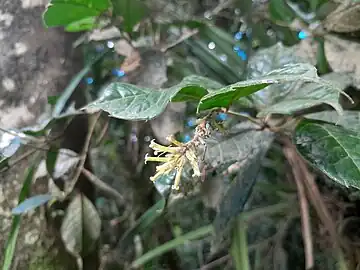 Flowers
Flowers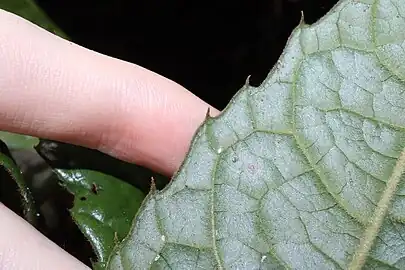 Leaf, showing toothed margins
Leaf, showing toothed margins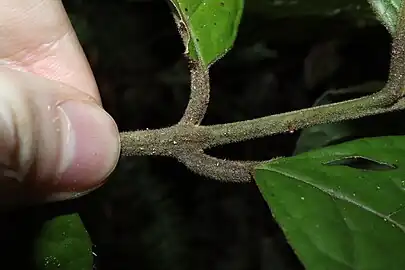 Twig and leaves
Twig and leaves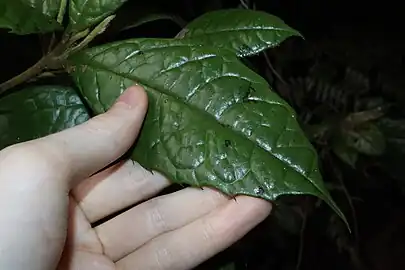
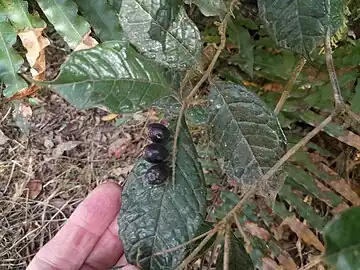 Fruit
Fruit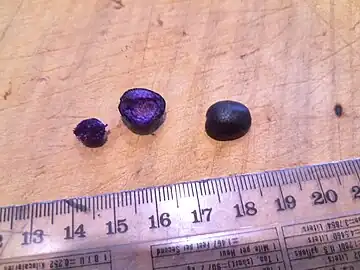 Fruit and seed
Fruit and seed
References
- "Species profile—Polyosma hirsuta". Queensland Department of Environment and Science. Queensland Government. 2022. Retrieved 26 July 2023.
- "Polyosma hirsuta". Australian Plant Name Index (APNI). Centre for Australian National Biodiversity Research, Australian Government. Retrieved 26 July 2023.
- "Polyosma hirsuta C.T. White". Plants of the World Online. Royal Botanic Gardens, Kew. Retrieved 26 July 2023.
- F.A.Zich; B.P.M.Hyland; T.Whiffen; R.A.Kerrigan (2020). "Polyosma hirsuta". Australian Tropical Rainforest Plants Edition 8 (RFK8). Centre for Australian National Biodiversity Research (CANBR), Australian Government. Retrieved 26 July 2023.
- Cooper, Wendy; Cooper, William T. (June 2004). Fruits of the Australian Tropical Rainforest. Clifton Hill, Victoria, Australia: Nokomis Editions. p. 226. ISBN 9780958174213.
- "Michael, Norman (Rev.) (1884 - 1951)". Australian National Botanic Gardens. Australian Government. Retrieved 26 July 2023.
External links
 Data related to Polyosma hirsuta at Wikispecies
Data related to Polyosma hirsuta at Wikispecies Media related to Polyosma hirsuta at Wikimedia Commons
Media related to Polyosma hirsuta at Wikimedia Commons- View a map of historical sightings of this species at the Australasian Virtual Herbarium
- View observations of this species on iNaturalist
- View images of this species on Flickriver